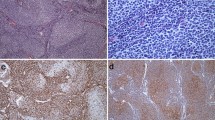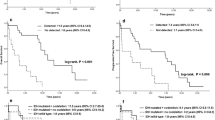Abstract
The pattern of recurrence and predictive factors for tumor progression, dissemination and survival in oligodendroglial tumors were investigated. 56 consecutive patients with oligodendroglial tumors were retrospectively analyzed to determine the predictive significance of various factors, including World Health Organization grade, loss of chromosomes 1p and 19q, and immunohistochemical features of TP53, O6-methylguanine-deoxyribonucleic-acid-methyltransferase, CD44H, nestin, and Ki-67. Eleven patients developed dissemination, and had significantly shorter post-progression survival compared to ten patients with local recurrence. Univariate analysis showed that retention of chromosome 1p or 19q, Ki-67 labeling index ≥ 25%, diffuse expression of nestin, and p53 labeling index ≥ 10% were unfavorable factors for overall, progression-free, and dissemination-free survival. Multivariate analysis showed that Ki-67 labeling index ≥ 25% and diffuse expression of nestin were significant for dissemination-free survival. In conclusion, post-progression survival shows significant differences between patients with local and disseminated recurrence. Ki-67 labeling index and nestin expression pattern are useful markers to predict dissemination.

Similar content being viewed by others
References
The Committee of Brain Tumor Registry of Japan (2003) Report of brain tumor registry of Japan (1969–1996). Neurol Med Chir Tokyo 43(Suppl):1–111. doi:10.2176/nmc.43.1
Coons SW, Johnson PC, Scheithauer BW et al (1997) Improving diagnostic accuracy and interobserver concordance in the classification and grading of primary gliomas. Cancer 79:1381–1393. doi:10.1002/(SICI)1097-0142(19970401)79:7<1381::AID-CNCR16>3.0.CO;2-W
Fortin D, Cairncross GJ, Hammond RR (1999) Oligodendroglioma: an appraisal of recent data pertaining to diagnosis and treatment. Neurosurgery 45:1279–1291. doi:10.1097/00006123-199912000-00001
Cairncross G, Berkey B, Shaw E et al (2006) Phase III trial of chemotherapy plus radiotherapy compared with radiotherapy alone for pure and mixed anaplastic oligodendroglioma: Intergroup Radiation Therapy Oncology Group Trial 9402. J Clin Oncol 24:2707–2714. doi:10.1200/JCO.2005.04.3414
van den Bent MJ, Carpentier AF, Brandes AA et al (2006) Adjuvant procarbazine, lomustine, and vincristine improves progression-free survival but not overall survival in newly diagnosed anaplastic oligodendrogliomas and oligoastrocytomas: a randomized European Organization for Research and Treatment of Cancer phase III trial. J Clin Oncol 24:2715–2722. doi:10.1200/JCO.2005.04.6078
McLendon RE, Herndon JEII, West B et al (2005) Survival analysis of presumptive prognostic markers among oligodendrogliomas. Cancer 104:1693–1699. doi:10.1002/cncr.21362
Levin N, Lavon I, Zelikovitsh B et al (2006) Progressive low-grade oligodendrogliomas Response to temozolomide and correlation between genetic profile and O6-methylguanine DNA methyltransferase protein expression. Cancer 106:1759–1765. doi:10.1002/cncr.21809
Hagel C, Stavrou DK (1999) CD44 expression in primary and recurrent oligodendrogliomas and in adjacent gliotic brain tissue. Neuropathol Appl Neurobiol 25:313–318. doi:10.1046/j.1365-2990.1999.00181.x
Coons SW, Johnson PC, Perl DK (1997) The prognostic significance of Ki-67 labeling indices for oligodendroglioma. Neurosurgery 41:878–885. doi:10.1097/00006123-199710000-00021
Dehghani F, Schachenmayr W, Laun A et al (1998) Prognostic implication of histopathological, immunohistochemical and clinical features of oligodendrogliomas: a study of 89 cases. Acta Neuropathol 95:493–504. doi:10.1007/s004010050830
Strojnik T, Røsland GV, Sakariassen PO et al (2007) Neural stem cell markers, nestin and musashi proteins, in the progression of human glioma: correlation of nestin with prognosis of patient survival. Surg Neurol 68:133–143. doi:10.1016/j.surneu.2006.10.050
Zulewski H, Abraham EJ, Gerlach MJ et al (2001) Multipotential nestin-positive stem cells isolated from adult pancreatic islets differentiate ex vivo into pancreatic endocrine, exocrine, and hepatic phenotypes. Diabetes 50:521–533. doi:10.2337/diabetes.50.3.521
Lebrun C, Fontaine D, Bourg V et al (2007) Treatment of newly diagnosed symptomatic pure low-grade oligodendrogliomas with PCV chemotherapy. Eur J Neurol 14:391–398. doi:10.1111/j.1468-1331.2007.01675.x
Ohgaki H, Kleihues P (2005) Population-based studies on incidence, survival rates, and genetic alterations in astrocytic and oligodendroglial gliomas. J Neuropathol Exp Neurol 64:479–489
Parsa AT, Wachhorst S, Lamborn KR et al (2005) Prognostic significance of intracranial dissemination of glioblastoma multiforme in adults. J Neurosurg 102:622–628
Grabb PA, Albright AL, Pang D (1992) Dissemination of supratentorial malignant gliomas via cerebrospinal fluid in children. Neurosurgery 30:64–71
Kato H, Fujimura M, Kumabe T et al (2004) PTEN gene mutation and high MIB-1 labeling index may contribute to dissemination in patients with glioblastoma. J Clin Neurosci 11:37–41
Louis DN, Ohgaki H, Wiestler OD, Cavenee WK (2007) WHO classification of tumours of the central nervous system, 4th edn. International Agency for Research on Cancer Press, Lyon, pp 54–67
Ogawa K, Yoshii Y, Toita T et al (2006) Hyperfractionated radiotherapy and multi-agent chemotherapy (procarbazine, ACNU and vincristine) for high-grade gliomas: a prospective study. Anticancer Res 26:2457–2462
Cunningham JM, Kimmel DW, Scheithauer BW et al (1997) Analysis of proliferation markers and p53 expression in gliomas of astrocytic origin: relationships and prognostic value. J Neurosurg 86:121–130
Friedman HS, McLendon RE, Kerby T et al (1998) DNA mismatch repair and O6-alkylguanine-DNA alkyltransferase analysis and response to Temodal in newly diagnosed malignant glioma. J Clin Oncol 16:3851–3857
Saito R, Kumabe T, Jokura H et al (2003) Symptomatic spinal dissemination of malignant astrocytoma. J Neurooncol 61:227–235
Smith JS, Parney IF, Lamborn KR et al (2007) Treatment for posterior fossa dissemination of primary supratentorial glioma. J Neurosurg 106:567–574
Khoshyomn S, Lew S, DeMattia J et al (1999) Brain tumor invasion rate measured in vitro does not correlate with Ki-67 expression. J Neurooncol 45:111–116
Wei LC, Shi M, Cao R, Chen LW et al (2007) Nestin small interfering RNA (siRNA) reduces cell growth in cultured astrocytoma cells. Brain Res 27(1196):103–112
Mangiola A, Lama G, Giannitelli C et al (2007) Stem cell marker nestin and c-Jun NH2-terminal kinases in tumor and peritumor areas of glioblastoma multiforme: possible prognostic implications. Clin Cancer Res 13:6970–6977
Günther HS, Schmidt NO, Phillips HS et al. (2008) Glioblastoma-derived stem cell-enriched cultures form distinct subgroups according to molecular and phenotypic criteria. Oncogene 27:2897–2909
Pilkington GJ (1994) Tumor cell migration in the central nervous system. Brain Pathol 4:157–166
Weller M, Berger H, Hartmann C et al (2007) Combined 1p/19q loss in oligodendroglial tumors: predictive or prognostic biomarker? Clin Cancer Res 13:6933–6937
Stander M, Peraud A, Leroch B et al (2004) Prognostic impact of TP53 mutation status for adult patients with supratentorial World Health Organization Grade II astrocytoma or oligoastrocytoma. Cancer 101:1028–1035
Aghi M, Gaviani P, Henson JW et al (2005) Magnetic resonance imaging characteristics predict epidermal growth factor receptor amplification status in glioblastoma. Clin Cancer Res 11:8600–8605
Giese A (2003) Glioma invasion—pattern of dissemination by mechanisms of invasion and surgical intervention, pattern of gene expression and its regulatory control by tumorsuppressor p53 and proto-oncogene ETS-1. Acta Neurochir Suppl 88:153–162
Brandes AA, Tosoni A, Cavallo G et al (2006) Correlations between O6-methylguanine DNA methyltransferase promoter methylation status, 1p and 19q deletions, and response to temozolomide in anaplastic and recurrent oligodendroglioma: a prospective GINCO study. J Clin Oncol 24:4746–4753
Kamiryo T, Tada K, Shiraishi S et al (2004) Correlation between promoter hypermethylation of the O6-methylguanine-deoxyribonucleic acid methyltransferase gene and prognosis in patients with high-grade astrocytic tumors treated with surgery, radiotherapy, and 1-(4-amino-2-methyl-5-pyrimidinyl)methyl-3-(2-chloroethyl)-3-nitrosourea-based chemotherapy. Neurosurgery 54:349–357
Acknowledgements
This work supported in part by Grants-in-aid for Scientific Research from the Ministry of Education, Culture, Sports, Science, and Technology of Japan (No. 18791005). The authors do not report any conflict of interest concerning the materials or methods used in this study or findings specified in this paper.
Author information
Authors and Affiliations
Corresponding author
Rights and permissions
About this article
Cite this article
Kanamori, M., Kumabe, T., Sonoda, Y. et al. Predictive factors for overall and progression-free survival, and dissemination in oligodendroglial tumors. J Neurooncol 93, 219–228 (2009). https://doi.org/10.1007/s11060-008-9762-7
Received:
Accepted:
Published:
Issue Date:
DOI: https://doi.org/10.1007/s11060-008-9762-7




